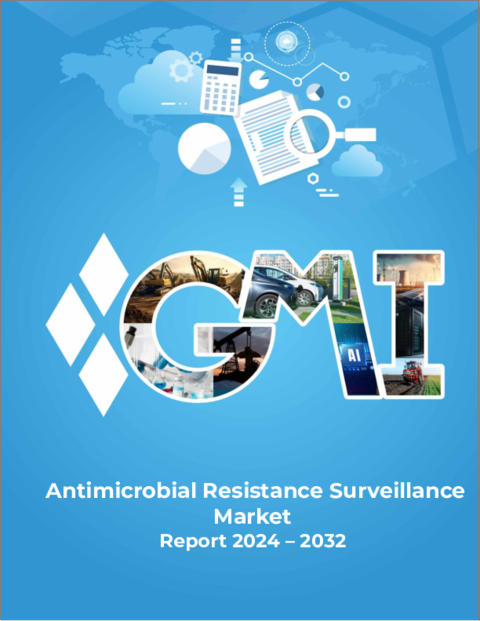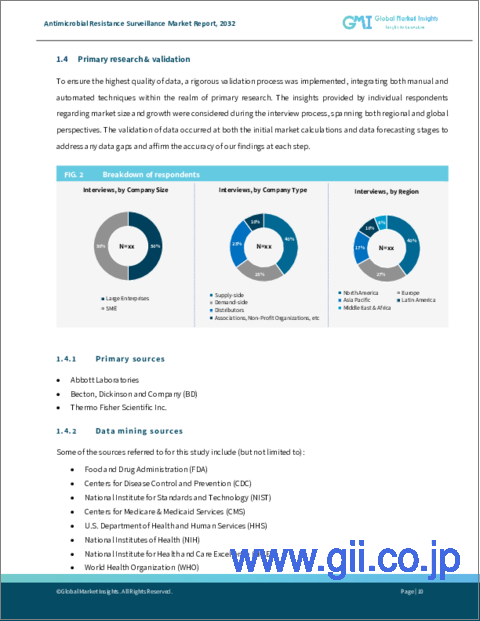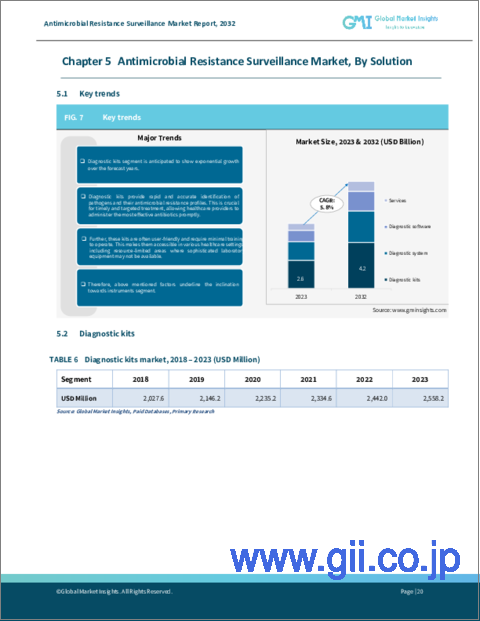|
|
市場調査レポート
商品コード
1460170
薬剤耐性サーベイランス(AMR対策)市場規模:ソリューション別、用途別、最終用途別、2024年~2032年予測Antimicrobial Resistance Surveillance Market Size - By Solution (Diagnostic Kits, Systems, & Software), Application (Public Health Surveillance, Laboratory Surveillance, Clinical Diagnostics), End-use (Hospitals, Clinics) & Forecast, 2024 - 2032 |
||||||
カスタマイズ可能
|
|||||||
| 薬剤耐性サーベイランス(AMR対策)市場規模:ソリューション別、用途別、最終用途別、2024年~2032年予測 |
|
出版日: 2024年02月29日
発行: Global Market Insights Inc.
ページ情報: 英文 100 Pages
納期: 2~3営業日
|
- 全表示
- 概要
- 目次
薬剤耐性サーベイランス(AMR対策)市場規模は、医療機関、研究機関、政府機関の連携努力により、2024年から2032年にかけてCAGR 5.8%で拡大すると予測されます。
パートナーシップの拡大が監視技術の革新を促進し、耐性病原体の検出と追跡のための高度なツールの開発を可能にしています。例えば、2023年6月、カナダ公衆衛生局の国立微生物学研究所(NML)の複数の研究者が、カナダにおける抗菌薬耐性の蔓延状況を調査しました。全国からデータを収集できるネットワークの必要性を認識したNMLは、臨床および獣医学研究室でAMRを検査した細菌および真菌サンプルからデータを収集する研究室ベースのモニタリングシステム、抗菌薬耐性ネットワーク(AMRNet)を構築しました。このような共同イニシアチブは、リソース、専門知識、データをプールして監視能力を強化し、抗菌薬耐性制御のより効果的な戦略につなげることで、市場の見通しを強化しています。
ソリューション別では、診断ソフトウェアセグメントによる薬剤耐性サーベイランス市場は、2024年から2032年にかけて6.3%の成長率が見込まれます。薬剤耐性サーベイランスのための高度なソフトウェアソリューションは、リアルタイムのモニタリング、データ分析、動向の特定を提供し、ヘルスケア施設における効果的な意思決定や感染対策に役立ちます。また、耐性病原体を迅速に特定し、タイムリーな介入や治療戦略を可能にします。さらに、AIとMLアルゴリズムの統合は、監視システムの精度と効率を向上させ、セグメントの成長にさらに拍車をかける。
用途に基づくと、公衆衛生監視セグメントの薬剤耐性サーベイランス産業は2023年にかなりの収益を上げ、2024年から2032年の間にCAGR 6.1%を描くと推定されます。世界中の公衆衛生機関は、抗菌薬耐性の広がりを監視し追跡するために高度な監視システムに依存しています。サーベイランスの強化により、タイムリーな介入、政策展開、より広範な規模で抗菌薬耐性と闘うための的を絞った介入が可能になります。耐性病原体の蔓延を防止し、患者の転帰を改善することにますます注目が集まる中、強固な公衆衛生サーベイランスソリューションに対する需要は高まると思われます。
地域的には、アジア太平洋地域の薬剤耐性サーベイランス産業は、2024-2032年の間に6.3%のCAGRを示すと設定されています。大規模で多様な人口とヘルスケア支出の増加が、この地域における効果的なサーベイランスソリューションの需要に拍車をかけています。感染症の制御とヘルスケア・インフラの改善を目的とした政府のイニシアチブがいくつかあります。さらに、抗菌剤耐性病原体の蔓延が進んでいることも、高度なサーベイランス技術の採用を促進し、地域の産業展望を増大させています。
目次
第1章 調査手法と調査範囲
第2章 エグゼクティブサマリー
第3章 業界洞察
- エコシステム分析
- 業界への影響要因
- 促進要因
- 抗菌薬耐性の増加
- 感染症の流行増加
- 意識向上とスクリーニングプログラム
- 診断技術の進歩
- 業界の潜在的リスク&課題
- 処置に伴う高コスト
- 標準化されたプロトコルの欠如
- 促進要因
- 成長可能性分析
- 規制状況
- 技術的展望
- ポーター分析
- PESTEL分析
第4章 競合情勢
- イントロダクション
- 企業シェア分析
- 競合のポジショニング・マトリックス
- 戦略展望マトリックス
第5章 市場推計・予測:ソリューション別、2018年~2032年
- 主要動向
- 診断キット
- 診断システム
- 診断ソフトウェア
- サービス
第6章 市場推計・予測:用途別、2018年~2032年
- 主要動向
- 公衆衛生サーベイランス
- 臨床検査サーベイランス
- 臨床診断
- その他の用途
第7章 市場推計・予測:用途別、2018年~2032年
- 主要動向
- 病院
- 診療所
- 研究・学術機関
- その他のエンドユーザー
第8章 市場推計・予測:地域別、2018年~2032年
- 主要動向
- 北米
- 米国
- カナダ
- 欧州
- ドイツ
- 英国
- フランス
- イタリア
- スペイン
- その他欧州
- アジア太平洋
- 日本
- 中国
- インド
- オーストラリア
- 韓国
- その他アジア太平洋地域
- ラテンアメリカ
- ブラジル
- メキシコ
- アルゼンチン
- その他ラテンアメリカ
- 中東・アフリカ
- サウジアラビア
- 南アフリカ
- アラブ首長国連邦
- その他中東とアフリカ
第9章 企業プロファイル
- Abbott Laboratories
- Accelerate Diagnostics, Inc.
- Becton, Dickinson and Company(BD)
- Biomereiux SA
- Bruker Corporation
- Himedia Laboratories Pvt. Ltd.
- Opgen Inc.
- Danaher Corporation
- Luminex Corporation
- Merck & Co., Inc.
- Thermo Fisher Scientific Inc.
Antimicrobial Resistance Surveillance Market size is projected to expand at 5.8% CAGR from 2024 to 2032 driven by the collaborative efforts among healthcare organizations, research institutions, and government bodies.
Increasing partnerships are fostering innovations in surveillance technologies, enabling the development of advanced tools for detecting and tracking resistant pathogens. For instance, in June 2023, several researchers at the Public Health Agency of Canada's National Microbiology Laboratory (NML) investigated the prevalence of antimicrobial resistance in Canada. Recognizing the need for a network that could capture data from across the nation, the NML created the Antimicrobial Resistance Network, or AMRNet, a lab-based monitoring system to collect data from bacterial and fungal samples tested for AMR in clinical and veterinary labs. Such collaborative initiatives pool resources, expertise, and data to enhance surveillance capabilities, leading to more effective strategies for antimicrobial resistance control, thereby augmenting the market outlook.
The overall industry is segmented into solution, application, end-use, and region.
In terms of solution, the antimicrobial resistance surveillance market from the diagnostic software segment is anticipated to witness 6.3% growth rate from 2024-2032. Advanced software solutions for antimicrobial resistance surveillance offer real-time monitoring, data analysis, and trend identification, aiding healthcare facilities in effective decision-making and infection control measures. They also provide rapid identification of resistant pathogens for enabling timely interventions and treatment strategies. Moreover, the integration of AI and ML algorithms enhances the accuracy and efficiency of surveillance systems, further adding to the segment growth.
Based on application, the antimicrobial resistance surveillance industry from the public health surveillance segment generated considerable revenue in 2023 and is estimated to depict a 6.1% CAGR between 2024 and 2032. Public health agencies worldwide rely on advanced surveillance systems to monitor and track the spread of antimicrobial resistance. Enhanced surveillance enables timely interventions, policy developments, and targeted interventions to combat antimicrobial resistance on a broader scale. With the increasing focus on preventing the spread of resistant pathogens and improving patient outcomes, the demand for robust public health surveillance solutions will rise.
Regionally, the Asia Pacific antimicrobial resistance surveillance industry is set to exhibit 6.3% CAGR during 2024-2032. The large and diverse population coupled with the rising healthcare expenditure are fueling the demand for effective surveillance solutions in the region. There are several government initiatives aimed at controlling infectious diseases and improving healthcare infrastructure. Additionally, the increasing prevalence of antimicrobial-resistant pathogens is driving the adoption of advanced surveillance technologies, thereby augmenting the regional industry outlook.
Table of Contents
Chapter 1 Methodology & Scope
- 1.1 Market scope & definition
- 1.2 Base estimates & calculations
- 1.3 Data collection
- 1.4 Forecast calculations
- 1.5 Data validation
- 1.6 Data sources
- 1.6.1 Primary
- 1.6.2 Secondary
- 1.6.2.1 Paid sources
- 1.6.2.2 Public sources
Chapter 2 Executive Summary
- 2.1 Industry 360-degree synopsis
Chapter 3 Industry Insights
- 3.1 Industry ecosystem analysis
- 3.2 Industry impact forces
- 3.2.1 Growth drivers
- 3.2.1.1 Rising incidence of antimicrobial resistance
- 3.2.1.2 Increasing prevalence of infectious diseases
- 3.2.1.3 Rising awareness and screening programs
- 3.2.1.4 Advancements in diagnostic technologies
- 3.2.2 Industry pitfalls & challenges
- 3.2.2.1 High cost associated with the procedures
- 3.2.2.2 Lack of standardized protocols
- 3.2.1 Growth drivers
- 3.3 Growth potential analysis
- 3.4 Regulatory landscape
- 3.5 Technological landscape
- 3.6 Porter's analysis
- 3.6.1 Supplier power
- 3.6.2 Buyer power
- 3.6.3 Threat of new entrants
- 3.6.4 Threat of substitutes
- 3.6.5 Industry rivalry
- 3.7 PESTEL analysis
Chapter 4 Competitive Landscape, 2023
- 4.1 Introduction
- 4.2 Company market share analysis
- 4.3 Competitive positioning matrix
- 4.4 Strategy outlook matrix
Chapter 5 Market Estimates and Forecast, By Solution, 2018 - 2032 ($ Mn)
- 5.1 Key trends
- 5.2 Diagnostic kits
- 5.3 Diagnostic systems
- 5.4 Diagnostic software
- 5.5 Services
Chapter 6 Market Estimates and Forecast, By Application, 2018 - 2032 ($ Mn)
- 6.1 Key trends
- 6.2 Public health surveillance
- 6.3 Laboratory surveillance
- 6.4 Clinical diagnostics
- 6.5 Other applications
Chapter 7 Market Estimates and Forecast, By End-Use, 2018 - 2032 ($ Mn)
- 7.1 Key trends
- 7.2 Hospitals
- 7.3 Clinics
- 7.4 Research & academic institutes
- 7.5 Other end-users
Chapter 8 Market Estimates and Forecast, By Region, 2018 - 2032 ($ Mn)
- 8.1 Key trends
- 8.2 North America
- 8.2.1 U.S.
- 8.2.2 Canada
- 8.3 Europe
- 8.3.1 Germany
- 8.3.2 UK
- 8.3.3 France
- 8.3.4 Italy
- 8.3.5 Spain
- 8.3.6 Rest of Europe
- 8.4 Asia Pacific
- 8.4.1 Japan
- 8.4.2 China
- 8.4.3 India
- 8.4.4 Australia
- 8.4.5 South Korea
- 8.4.6 Rest of Asia Pacific
- 8.5 Latin America
- 8.5.1 Brazil
- 8.5.2 Mexico
- 8.5.3 Argentina
- 8.5.4 Rest of Latin America
- 8.6 Middle East and Africa
- 8.6.1 Saudi Arabia
- 8.6.2 South Africa
- 8.6.3 UAE
- 8.6.4 Rest of Middle East and Africa
Chapter 9 Company Profiles
- 9.1 Abbott Laboratories
- 9.2 Accelerate Diagnostics, Inc.
- 9.3 Becton, Dickinson and Company (BD)
- 9.4 Biomereiux SA
- 9.5 Bruker Corporation
- 9.6 Himedia Laboratories Pvt. Ltd.
- 9.7 Opgen Inc.
- 9.8 Danaher Corporation
- 9.9 Luminex Corporation
- 9.10 Merck & Co., Inc.
- 9.11 Thermo Fisher Scientific Inc.






